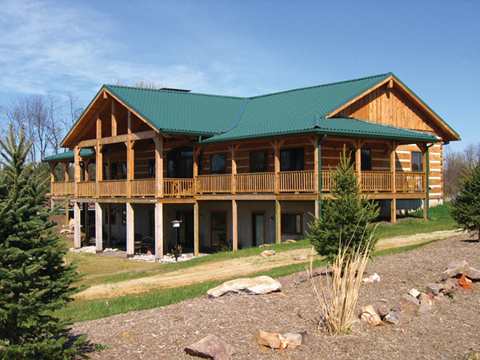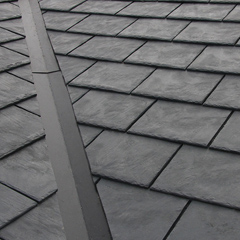When you hear the word “roof” probably the first image that pops into your head is the tried and true asphalt shingle roof that is ubiquitous in the United States. When you dream of your log home, you most likely envision a more rustic roof that will complement the wood and architectural style you have selected. The good news is that you can have a beautiful roof that enhances your log home and is also durable, sustainable, and energy-efficient.
If you are considering going “green” for your roof, you’ll want to look for a sustainable product. The first criterion is durability, meaning that it will last for a long time. A product with a long life span reduces pollution and landfill waste. Second, you need to know how much energy goes into extracting and processing the raw materials and transporting them to the building site. Third, the product needs to perform optimally and give you immediate results in the form of savings on your energy bills. Finally, are the materials used on your roof reusable or recyclable? We’ll take a look at some of the classics and some of the new roofing products to see how they measure up the sustainability criteria.
Asphalt Shingles
The reason asphalt shingle roofs are so popular is that they are inexpensive and easy to install. There are three main types: organic, fiberglass, and laminated/ architectural. Organic asphalt
shingles are made of waste paper saturated with asphalt to make them waterproof, then coated with adhesive asphalt that is embedded with ceramic granules. If the granules contain coated leachable paint they help protect the shingles from discoloration
and algae; they also reduce moss growth. They are prone to fire damage. Because asphalt is a petroleum product, organic asphalt shingles are not eco-friendly. They may last 20-50 years and are not recyclable
or reusable at the end of their lifespan. In fact, they add 20 billion pounds of waste to U.S. landfills every year. Organic asphalt shingles last longer in cooler climates; drastic changes in temperature can damage them.
Fiberglass shingles have a base layer of glass fiber reinforcing mat. The fiberglass is bonded with urea-formaldehyde resin then coated with asphalt. Fiberglass shingles have about 40% less asphalt than organic shingles and are more fire resistant. Urea-formaldehyde was commonly used in home insulation in the 1970s. A decade later it was revealed that the insulation emits toxic formaldehyde when it is exposed to heat. In a roof application, the formaldehyde off-gasses into the atmosphere, which contaminates the air in a community.
Laminated/architectural asphalt shingles consist of two layers bonded with an asphalt sealant then coated with a layer of granules. They are heavier, more expensive, and more durable that the other types. Aesthetically, they give the roof a more varied, contoured look. They are wind-resistant but susceptible to mold and algae.
Shakes
Cedar Shakes. In North America shakes are made from Western Red Cedar, which provides good insulation properties, long-lasting weather protection, and rustic appeal. They are durable if they are maintained properly with a fungicide and preservative. In spite of Western Red Cedar’s low ignition rate, untreated cedar shakes can be a fire hazard; treating them with a fire retardant helps diminish their combustibility. Shakes, unlike shingles, are split rather than sawn. If you choose a shake roof, be sure the wood is a Forest Certified Product (FCP) and that the wood has been edge grain cut to prevent warping and splitting when they dry. Members of the Cedar Shakes & Shingles Board use salvaged logs that would otherwise be left on the forest floor. The average lifespan of a cedar shake roof is 30 to 40 years.
Rubber Shakes. Rubber roof shakes are made from recycled tires. The tire wall is cut out and the tread section is cut into large pieces. The tread is buffed off and the rubber is coated with recycled sawdust or slate dust. Then the pieces are molded into shape, often with a pattern or texture that mimics wood, tile, or slate. The tire section retains the steel belt, which makes the rubber shingles stronger and last longer. Rubber shingles won’t rot, discolor, curl, bend, crack, or take on moisture. Most recycled rubber shingles come with a 30-year warranty. They make great use of a product that would otherwise occupy a landfill.
Concrete
You may think that concrete roof tiles are dull with an industrial feel, but that’s not the case at all. They can be manufactured to look like various types of shakes and tiles and come in a large variety of colors and textures. Concrete tile roofs are very durable; they are impervious to high winds, resist solar damage, and weather hail storms and have a top fire rating. Concrete is a good insulator and resists heat transfer because of the air that flows under the tiles. Concrete roofing may cost more up front, but most companies guarantee their products for a minimum of 60 years.
Metal
Metal roofing is very popular among log home buyers, whether it be standing-seam, also known as vertical panel, or made to look
like slate, shingles, shakes, or tile. It has rustic appeal and harkens back to earlier times when metal roofs were found on both farmhouses and more urban dwellings. Although some metal roofs are made from copper or aluminum, the most common material is steel, which is less expensive and more readily available. Most metal roofing products today have approximately 25% recycled content. A metal roof is lightweight and resists wind, hail, ice, earthquakes, and fire. It requires little maintenance and can last from 30 to 100 years. It is 100% recyclable at the end of its life.
Today’s metal roofing is most energy efficient when it has been painted with a high-quality paint such as Kynar 500. It is baked on the metal in seven coats and comes in multiple colors. The old adage says that a white roof will reflect the most heat, but the new cool metal roofs, painted light or dark, cool the home by re-emitting up to 90% of the absorbed solar radiation. A painted metal roof retains 95% of its reflectance and emittance over time.
There is a lot to consider when selecting a roofing product for your log home. You should begin by consulting with your log home producer or architect to determine what product is right for the climate and design of the home. Aesthetics are important to the overall style of your home and there are many “green” choices available that meet both style and energy-efficiency criteria. There are also many excellent resources available that will aid you in the selection process. Good places to start include the U.S. Department of Energy and EnergyStar web sites. No matter which type of roof you select, make sure you hire a reputable and experienced contractor to do the installation. An asphalt shingle roof may be relatively easy to install, but other roofing materials require specific skills and knowledge.


 ©
©  ©
©  ©
©